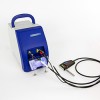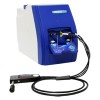
Quantitative Raman
Raman spectroscopy has excellent specificity and selectivity which makes it an effective tool for both nondestructive qualitative identification and quantitative analysis. The Raman signal intensity is proportional to the number of molecules in a sample, determining the quantity within a given sample.
Quantitative Raman is applicable to measurements made for all types of samples, as part of a full material characterization. The functions can determine the composition of a mixture or blend, verify a product contains the correct concentration of ingredients, and detect impurities in samples. Raman is also utilized for reaction monitoring, giving quantitative results and trends for the formation of chemical species (product) and starting material consumption.
In the pharmaceutical industry Raman is used in quantitating active substances in pharmaceutical formulations and finished products (content uniformity), measuring crystallinity, and quantifying the concentration of different polymorphic forms. Active pharmaceutical ingredients (APIs) are predisposition to present materials with very strong Raman signals (while excipients and fillers are not always "strong" Raman scatterers) the concentration change of the API can be detected and a calibration model of the signal in conjunction with the concentration can be developed. It is important to measure the quantitative measurement of APIs in pharmaceutical products in order to verify the quality, safety and authenticity of drug products. Raman can be used to quantitatively measure the level of APIs, and give content uniformity of solid dosage forms.
Raman spectroscopy has the advantage of being able to make measurements on solid samples directly, or through transparent materials, for example products in blister packs or formulations in glass vials. With a Raman spectrum including information about the full samples matrix measured, it can be used for multicomponent analysis from a single measurement.
Products
High throughput, Highly Sensitive, High Resolution Raman System
Highly Sensitive, High Resolution Fiber Optic Raman System
Request a Quote or Information
Application Notes
Read the full application note
Read the full application note
Read the full application note
Read the full application note
Read the full application note
Read the full application note
Read the full application note
Read the full application note


